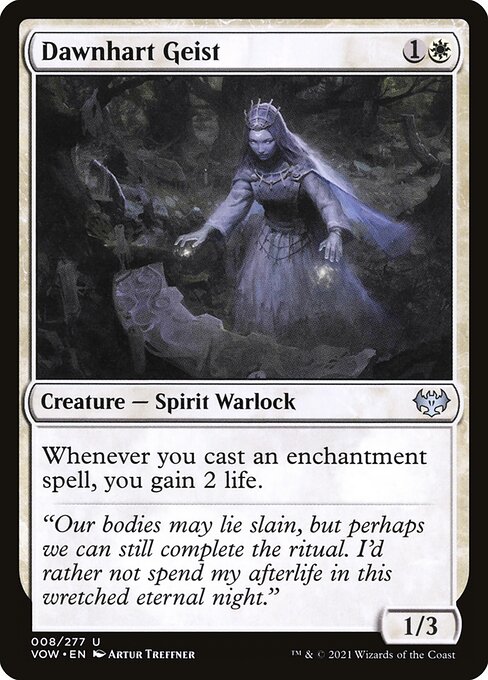
Image courtesy of Scryfall.com
Dawnhart Geist in One-on-One Duels
In the tight arena of one-on-one duels, every point of life and every card draw matters. Dawnhart Geist, a white creature from Innistrad: Crimson Vow, slides into that space with a tidy package: a 1/3 body for two mana, and an evergreen trigger that rewards you for playing enchantments. When you cast an enchantment spell, you gain 2 life. That life swing, repeated over a match, can tilt races that begin with even the slimmest of margins. The spirit warlock arrives with a calm, ceremonial aura—perfect for decks that lean into control, stall, and gradual advantage. 🧙♂️🔥
White’s enchantment-centric playbook is a natural fit for Dawnhart Geist. The card’s lifegain engine doesn’t rely on big mana or splashy cards; it rewards you for the very act of casting enchantments. In a 1v1 duel, that translates into steady resilience: you can weather a fast start, incrementally gain life, and keep your opponent off their game plan without needing to commit overwhelming forces early. Each enchantment you cast—whether it’s a protective aura, a spell that draws a card, or a global enchantment that steadies the board—provides a small, reliable lifeline. When you string together a sequence of enchantment plays, you watch the Geist’s life-trail become a breadcrumb trail toward victory. ⚔️💎
Engrams of Enchantment: building around Dawnhart Geist
To maximize the Geist’s potential, lean into a lean enchantment suite. You’ll want a balance of cheap, game-sustaining enchantments and a few longer-term lock pieces that help you stabilize the board. The beauty of this approach is that it doesn’t demand a huge mana investment; you’re sequencing plays that cast enchantments while your life total quietly climbs. Enchantments that protect your board, subtly draw into answers, or apply curated pressure on your opponent all play nicely with the Geist. The core idea is to create a rhythm: cast an enchantment, gain life, stabilize, and then deploy the next enchantment to extend your advantage. The effect is a patient crescendo—your opponent feels the pressure not from a single blow, but from a slow, inexorable drift toward equality becoming swifter than they anticipated. 🎨
- Early game (turns 1–3): Establish your plan with low-cost enchantments. Casting auras on your own blockers or protective enchantments on your poised threats begins the lifegain loop early, setting up your later turns.
- Midgame: Dawnhart Geist becomes a reliable insurance policy. Every enchantment spell you cast nudges your life total upward, which helps you weather burn spells or a sudden creature swing while you shore up the defenses.
- Late game: The life-trail you’ve built becomes a narrative of endurance. As you cast more enchantments, you outlast aggressive contenders and present a consistent, unbroken tempo that your opponent must answer or concede the race.
Against aggressive decks, the Geist’s lifegain is a natural counterweight to pressure. Against control, you lean into an enchantment cadence—draw-enhancing enchants, protective auras, and board-stabilizing enchantments—that let you accumulate life while you navigate through their answers. The key is timing: you don’t need to cast every enchantment as soon as you draw it; you want the lifegain to land at moments when it disrupts your opponent’s plan and cushions you from their removal heavy counters. 🧙♂️⚔️
Flavor note: Dawnhart Geist embodies the ritual continuity of Innistrad lore—the idea that even when mortal forms are laid low, the work of the ritual persists. It’s a perfect mirror for a deck built on patient, enchantment-driven advantage that refuses to quit in a late, grindy duel.
From a design perspective, the card slots comfortably into Modern and many eternal formats, while also being accessible in older formats thanks to its two-mana investment and lifegain payoff. The uncommon rarity and the flavorful Artur Treffner illustration reinforce the theme of resilience and quiet resolve. The lifegain trigger is clean, intuitive, and easy to appreciate in a one-on-one setting, where every draw and play begins to feel personal as your life total climbs back toward parity. The interplay between aura-casting and life gain is a satisfying expression of white’s “protect and outlast” philosophy—a design that whispers, rather than shouts, victory. 🧙♂️💎
Collectors often look for that resonance between flavor and function. Dawnhart Geist delivers on both fronts: its martial, gothic vibe in Crimson Vow’s art blends with a clearly defined, repeatable effect. The result is a card that’s not only playable, but also a memorable moment in a duel where a single enchantment can swing the balance, turn the tide, and etch its own little legend into the match. The “2 life per enchantment” mechanic feels like a quiet ritual of endurance—precisely the kind of story MTG fans adore. 🎲
Thinking about a practical setup for a 1v1 shell, consider pacing your enchantments to maximize both protection and value. You don’t chase burst; you choreograph incremental wins that accumulate. The deck’s strength in a duel comes from a steady rhythm: you cast, you gain, you stabilize, you advance. And as you log more enchantment spells, you’ll find that the Geist becomes less about a single combat stroke and more about a confident, patient strategy that refuses to surrender its tempo. 🧙♂️🔥
Non-slip Gaming Mouse Pad 9.5x8in Anti-Fray Rubber BaseMore from our network
- https://blog.digital-vault.xyz/blog/post/using-limited-time-offers-to-turbocharge-conversions/
- https://blog.digital-vault.xyz/blog/post/jokulhaups-and-the-rise-of-mtg-joke-cards/
- https://blog.digital-vault.xyz/blog/post/distant-hot-stars-silent-glow-revealed-by-multi-epoch-astrometry/
- https://blog.digital-vault.xyz/blog/post/gorion-wise-mentor-mtg-artist-profile-and-card-art-highlights/
- https://crypto-acolytes.xyz/blog/post/steam-vs-epic-which-has-the-better-deals/